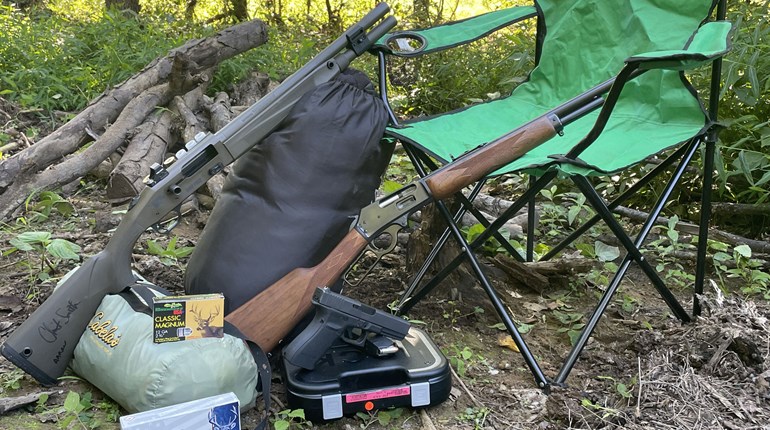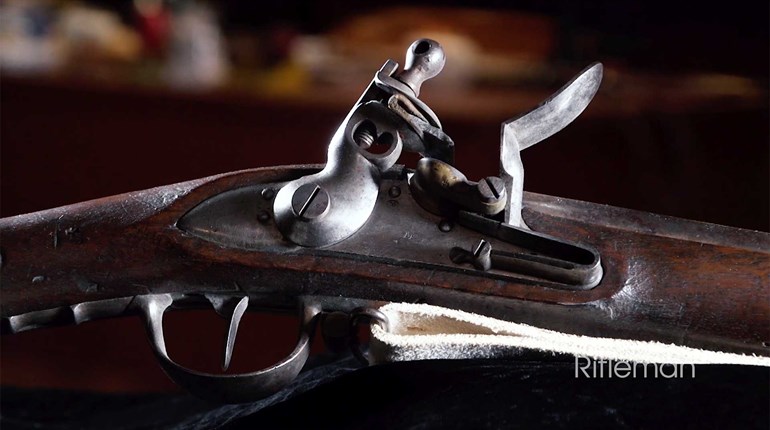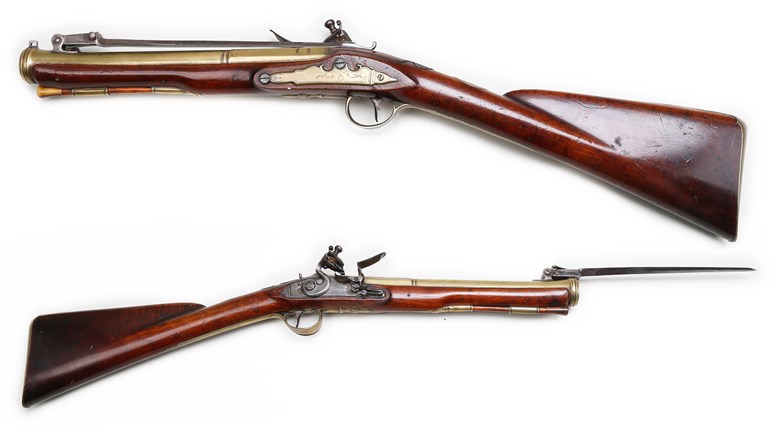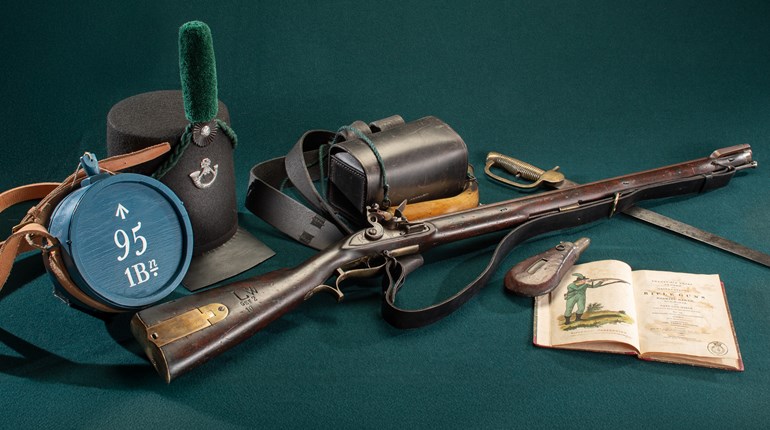
The remnants of the Mohican tribe, who have an adopted half-white son, Hawkeye (Daniel Day-Lewis), are stalking prey. More accurately, they’re conducting a fast-paced drive. Two young men, Hawkeye and Uncas (Eric Schweig) link up, just as Chingachgook (Russell Means)—and Uncas’ father—pushes the quarry to them. The composition builds to a crescendo as duo crest a hill and Hawkeye takes aim with his flintlock rifle on an escaping bull elk. At the shot, the animal topples end-over-end over a small cliff, becoming still. Finality by flintlock.
Since I first watched the film “The Last of the Mohicans,” which was released in 1992, I’ve been enamored with flintlock rifles. Not only did the abovementioned scene captivate me, so too did many others throughout the movie. Hawkeye and, at times, Uncas, worked wonders with those rifles. Yes it’s Hollywood, but it’s not totally inaccurate. In fact, study the late 18th century—particularly the Revolutionary War—and you’ll quickly grasp the capabilities of said weapons and the men who wielded them for food, protection and freedom. Too, you’ll learn of the various makers and variations in design (geographically and over time). It’s a topic rich in history.
If you’re a flintlock enthusiast, you already get it; if not, below are six reasons to take up the traditional rifle. Without further ado …

Become a Better Marksman
According to the NRA Firearms Sourcebook, a flintlock is “a muzzleloading firearm ignition system wherein a piece of flint is secured to the hammer in such a manner as to strike steel upon [the] hammer release, causing sparks to ignite powder contained in the ignition system, for subsequent ignition of the main powder charge.” While the aforementioned is a decent definition of “flintlock,” it foregoes important details necessary to understand their attendant peculiarities. Thus, pulling the trigger releases the hammer, which holds the chunk of flint. As it falls, the flint strikes the face of the frizzen, which subsequently lifts upward. A shower of sparks is directed downward, into the pan holding the small charge of fine blackpowder. It ignites. The flame (and attendant heat) is directed through the barrel’s touch hole and into the larger primary charge, thereby firing the gun. While the latter processes occur quickly, there is still a noticeable delay.

With modern rimfire and center-fire ammunition and the firearms that utilize it, the firing process is seemingly instantaneous. Technically it’s not, of course, but it is fast. Lock times are measured in milliseconds. Those in flintlocks are much longer.

Why does this matter? From the moment the shot is initiated by pulling the trigger, you must remain steadfast in your sight picture or the shot will deviate off course—guaranteed. Any movement is too much. Seems easy, but it’s not. As you’re taking aim, essentially a quasi-fireworks display is occurring on your periphery. And that’s just the ignition of the priming charge. Yet to occur is detonation of the main powder charge, sufficient pressure to be built to move the projectile, and the period of time it takes for the bullet to traverse the length of the bore. It all adds up.

At first, firing a flintlock is unsettling and, frankly, awkward; however, with practice you’ll disregard the chaos and your sight picture will remain unchanged until the projectile hits the target. That same follow-through will improve marksmanship with modern rifles, too. How? Focus on the fundamentals, such as controlling your breathing, aligning the sights (and maintaining such), and easing the trigger until it breaks. Sight picture is constant.

I can attest that shooting a flintlock is beneficial for marksmanship; in fact, if time permits, before testing a “modern” rifle for accuracy, I’ll spend time shooting my 39-inch-barreled, .54-cal. Davide Pedersoli Frontier flintlock. After sending a handful of patched, 0.530-inch-diameter Hornady lead round balls downrange, adhering to the fundamentals with a contemporary rifle—and thus shooting accurately—is simple.

Understanding Ballistics and the Intricacies of Fine-Tuning Loads
Interest in handloading metallic cartridges and shotshells ebbs and flows depending on politics, happenings and the news. During ammunition shortages, the practice increases markedly; however, the opposite holds true when supplies exceed demand and sales abound. For the diehard handloader, though, it’s a lifestyle; creating your ammunition instills a sense of pride and accomplishment—especially when it’s used to down a trophy animal, fill the freezer, or, in the case of rifles, produce small clusters of bullet holes at extended range. Whatever the use, top performance comes from a firm understanding of the components and time spent fine-tuning.

The flintlock is no different. When using any muzzleloader, handloading is involved. You’re not simply taking ammunition that matches the barrel stamping and sending rounds downrange; rather, you must understand the difference between Fg, FFg, FFFg, and FFFFg granulations—for example, all flintlocks are primed with fine FFFFg black powder—and test it with multiple charge weights (measured by volume and within the range determined by the rifle’s maker). Moreover, you’ll likely need to experiment with varying ball diameters and patch thicknesses to find the perfect “load” for your flintlock. Once you do, though, the accuracy and downrange ballistics will be spectacular. Knowledge is power.

More Time Afield
Many states offer separate muzzleloader seasons—or specifically designated units/areas—for big game, such as whitetail deer and elk, or permit their use instead of a shotgun (though this is becoming less popular due to the increasing allowance of rifles using straight-walled cartridges instead). As such, muzzleloaders afford you additional opportunities afield. But flintlocks, which can generally be used in lieu of a rifle during rifle season, can get you in the woods even more. How? In at least one state—Pennsylvania—there is a separate, flintlock-only season.

According to the Pennsylvania Game Commission’s website, the hunter must use “flintlock-ignition, single-barrel long guns manufactured prior to 1800, or similar reproduction of an original muzzleloading single-barrel long gun .44-caliber or larger, or .50-caliber or larger handgun using a single projectile. It is unlawful to use telescopic sights.” Therefore, not only will a flintlock serve you during muzzleloader and rifle seasons, but also when modern, inline muzzleloaders cannot be used. Best of all, the hefty, oversized projectiles that muzzleloaders launch are downright deadly on big game. Our forefathers used them to good effect and so can you.

Should you hunt in a state or locality that frowns upon lead projectiles, don’t fret; TomBob Outdoors makes leadless, “non-toxic” ITX round balls with close-to-lead density in the following calibers: .32; .45; .50; .54; and .62. The 0.524-inch-diameter ITX has performed admirably in my .54-cal. Pedersoli.

Attend Events and Meet Others
I’m not speaking about speed dating or other singles events; rather, here I’m discussing venues focused on muzzleloaders (percussion and flintlock), mountain man traditions, the West and similar. Truth be told, the number of traditionalists—and flintlock toters in particular—is small when compared to other firearms enthusiasts, such as those who use ARs, polymer handguns and precision rifles. That being said, the community is remarkably passionate and eager to share its knowledge. Look at the multitude of YouTube videos about flintlocks and related topics for ample evidence of this. But, there are also opportunities to socialize with like-minded old-school hunters and shooters at the numerous mountain man-type rendezvous each year, as well as to buy customized items, handle (and sometimes fire) various firearms, compete, establish contacts and learn more about the nation’s history.
Even if you cannot travel to attend, some gatherings—including the Green River Rendezvous, presented by the Museum of the Mountain Man, Sublette County Historical Society, Inc., in Pinedale, Wyo.—are now livestreamed and recorded. The NRA also has a rendezvous at its Whittington Center in Raton, N.M. The event takes place every year from the second to third Sunday of June. There are a host of events, including rifle, pistol and smoothbore competitions; open irons and patched round ball; and archery, among others. Never before has access to the heritage of flintlocks and the people who used them—and still do—been so easily accessible.

Connect with the Past
The NRA Firearms Sourcebook attributes the development of the flintlock design to Frenchman Marin Le Bourgeoys in 1610. In time, they would be widely used throughout the colonies (and then states) until the mid-1800s. Thus, to understand the history of the United States, and how we, as a people, ended up in our current state, you must appreciate flintlocks. The firearms not only fed the fledgling nation but protected its residents from domestic and international threats. Ultimately, flintlocks evicted an intolerable, tyrannical distant government and created a nation.

When you handle a flintlock rifle, you wind back the clock. You recognize the time-consuming loading process and what it meant for those handling them in the nation’s earliest days and at war. So too can you imagine what it was like to deal with precipitation and humidity (ruined powder), an insufficient spark, a flash in the pan but no discharge, and other issues that meant no dinner or means of protection. Flintlocks foster appreciation.

Inexpensive Fun
The subhead states it best. Flintlocks are great for all of the previously mentioned reasons, but above all, they’re fun to shoot. With a modest charge, the lengthy, weighty long guns generate little perceived recoil and yet pack a wallop. My .54-caliber flintlock never ceases to draw a crowd at the range, many of whom fancy something other than the latest synthetic-stocked rifle, and all of whom gawk at the oversized perforations it produces. Don’t get me wrong; I enjoy shooting modern rimfire and center-fire rifles. But, some of my happiest times on the range were due to the flintlock.

What’s more, flintlocks are inexpensive to shoot. There is no case or primer, only a patch and a ball—the least costly projectile—or conical (depending on the twist rate in the rifle) and blackpowder. The latter is widely available and inexpensive. The result is more time on the range at less cost, so you’re better prepared come hunting season.

Should you now be ready to take up a flintlock rifle, know that there are production and custom makers, with little crossover in where they’re sold. For a quality reproduction, such as those by Pedersoli, search the SKUs of large retailers, such as MidwayUSA and Dixie Gun Works, to name a few. Custom rifles can be had by the various makers, which a simple Google search will reveal. Additionally, access the “Artwork for Sale” on the site of the Contemporary Longrifle Association (CLA) and The Gun Works Muzzleloading Emporium for new and second-hand custom rifles. Don’t discount the latter; you can get a tremendous deal on a beautiful flintlock by opting for “used.”
The blockbuster “The Last of the Mohicans” certainly impacted my life. It’s been three decades since I first viewed the film and Hawkeye’s exploits, and my fascination with flintlocks has only grown. I’ve covered six reasons why you should own one. Be forewarned, though, once you get started, there’s no turning back—and that’s a good thing.




































